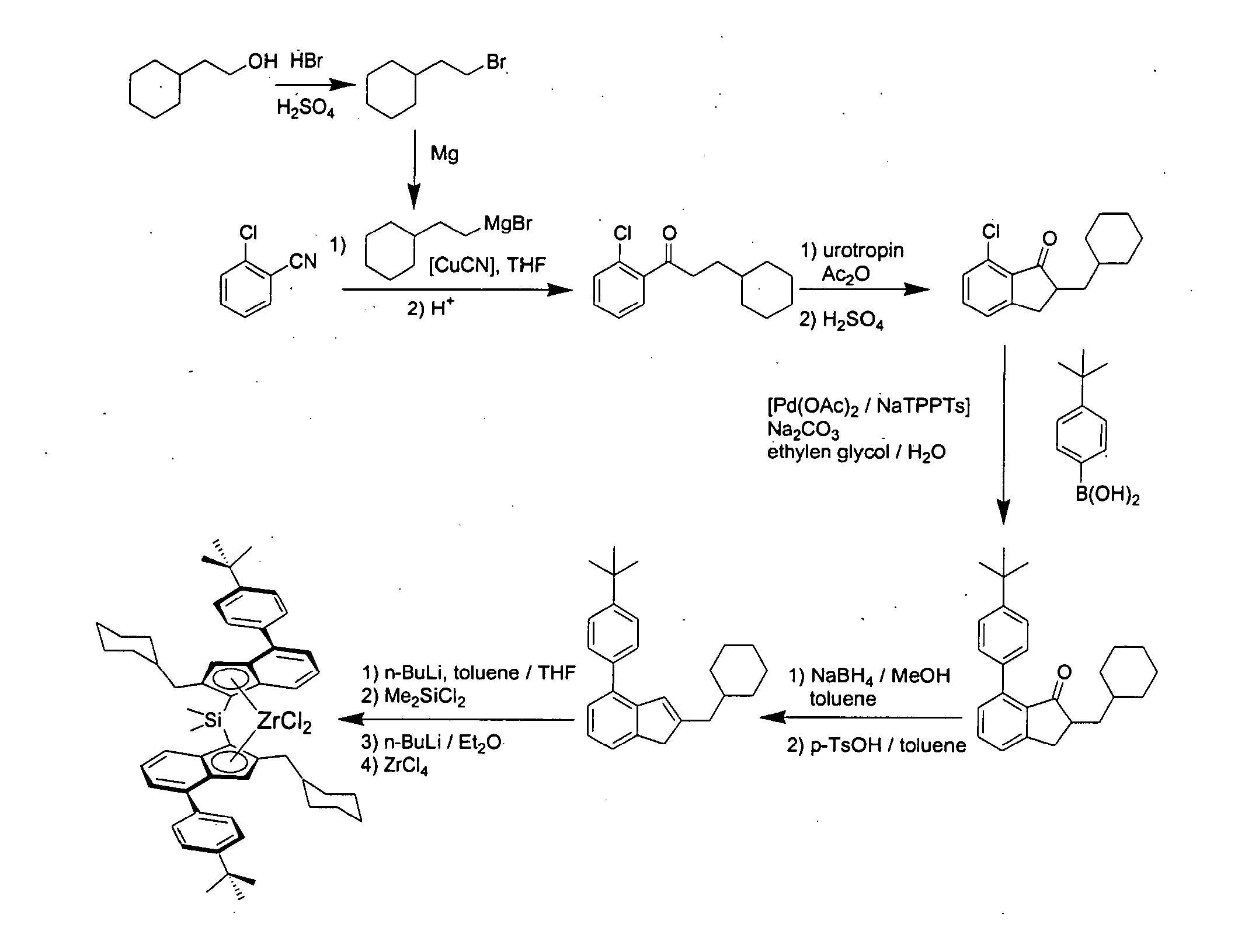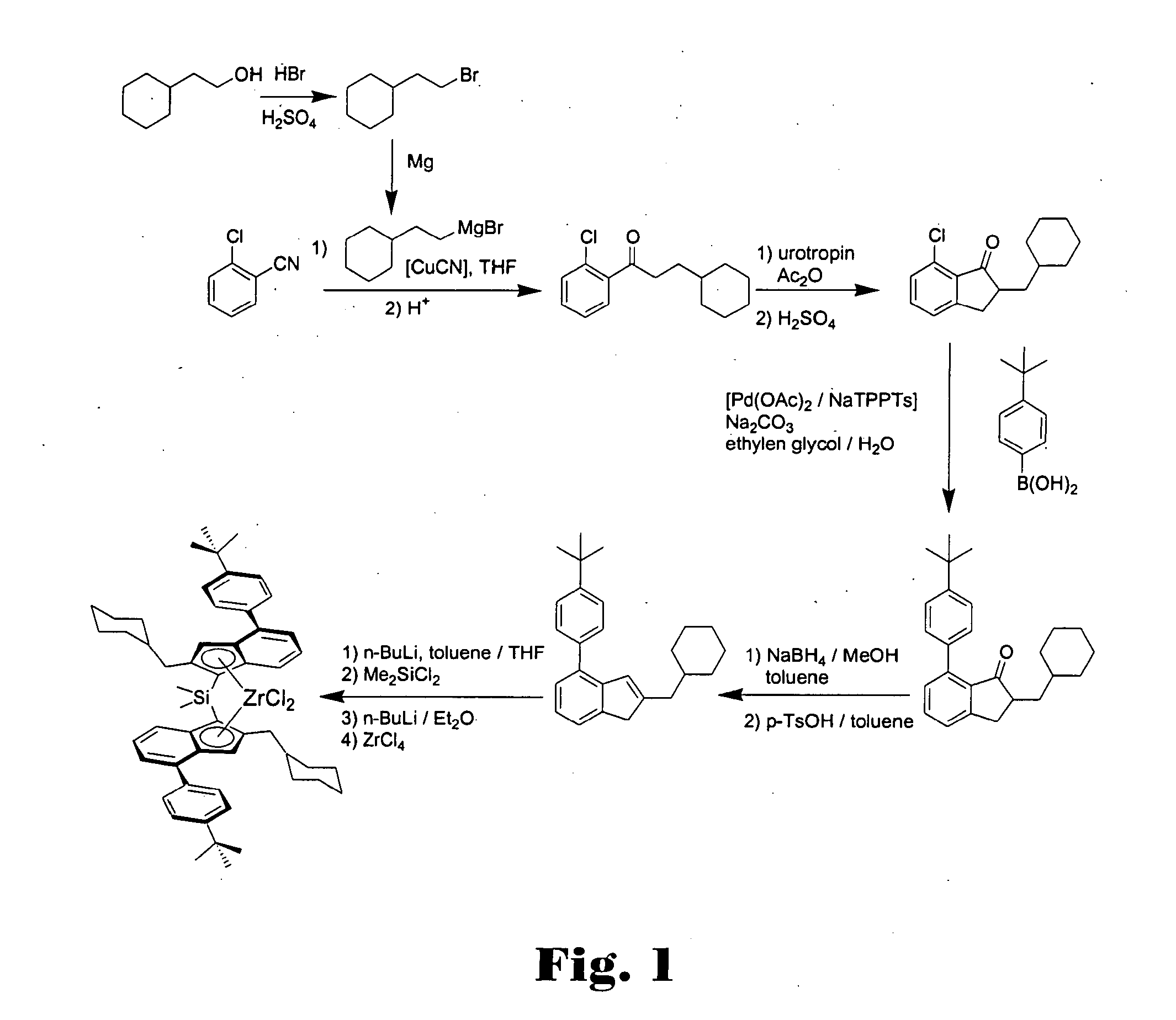Metallocene compounds, catalysts comprising them, process for producing an olefin polymer by use of the catalysts, and olefin homo-and copolymers
a technology of olefin polymer and catalyst, which is applied in the direction of catalyst activation/preparation, organic compound/hydride/coordination complex catalyst, and metalocene catalyst for polypropylene, which can solve the problems of inability to produce propylene-ethylene copolymers of high molar mass, and inability to prevent the -hydrogen transfer to the ethylene comonomer, etc., to achieve high melting point, high molar mass
- Summary
- Abstract
- Description
- Claims
- Application Information
AI Technical Summary
Benefits of technology
Problems solved by technology
Method used
Image
Examples
example 1
Dimethylsilandiyl-bis-(2-(cyclohexylmethyl)-4-(4′-tert-butylphenyl)-1-indenyl)-zirconium dichloride
(2-Bromo-ethyl)-cyclohexane
[0582]
[0583]In a 1 l-roundbottom flask equipped with a reflux condenser 164 g concentrated sulphuric acid and 200 g hydrobromic acid (48% in water) were added subsequently under cooling with an ice bath to 88.7 g (0.693 mole) 2-cyclohexyl-ethanol. The mixture was refluxed for 6 h and after cooling to room temperature given to 400 g of ice. The aqueous phase was extracted with 400 ml pentane. The organic layer was washed with a 2 M NaOH-solution and with water, dried over magnesium sulphate, and the solvent was removed in vacuo. The product was distilled in vacuo to yield 112.7 g (85%) of (2-bromo-ethyl)-cyclohexane as a colourless oil. 1H-NMR (400 MHz, CDCl3): δ=3.40 (2H, t, CH2Br), 1.73-1.61 (m, 7H), 1.44 (m, 1H), 1.26-1.11 (m, 3H), 0.92-0.84 (m, 2H) ppm.
1-(2-Chloro-phenyl)-3-cyclohexyl-propan-1-one
[0584]
[0585]15.57 g (640 mmole) Magnesium turnings were plac...
example 2
Dimethylsilandiyl-bis-(2-(cyclohexylmethyl)-4-(1-naphthyl)-1-indenyl)-zirconium dichloride
7-(1-Naphthyl)-2-cyclohexylmethyl-indan-1-one
[0594]
[0595]18.5 g (70.4 mmole) 7-Chloro-2-cyclohexylmethyl-indan-1-one, 14.5 g (1.2 eq.) naphthyl boronic acid, 16.4 g sodium carbonate, 230 ml ethylene glycol and 45 ml water were placed in a 1 l-roundbottom flask equipped with a mechanical stirrer and a reflux condenser. The mixture was degassed three times by slight evacuation and recharging with argon. A premixed catalyst solution consisting of 32 mg (0.2 mole %) palladium acetate, 0.94 ml NaTPPTS (2.6 M in water, 0.8 mole %) and 3 ml of water was added and the mixture was refluxed at 125° C. until complete conversion (approx. 5 h). 100 ml of water were added and the mixture was extracted three times with 100 ml of toluene each. The combined organic layers were washed twice with 100 ml water and once with 100 ml of a saturated sodium chloride solution. Drying over magnesium sulphate and evaporat...
example 3
Dimethylsilandiyl-bis-(2-(cyclohexylmethyl)-4-(4′-methylphenyl)-1-indenyl)-zirconium dichloride
7-(4′-Methylphenyl)-2-cyclohexylmethyl-indan-1-one
[0600]
[0601]24.16 g (91.9 mmole) 7-Chloro-2-cyclohexylmethyl-indan-1-one, 15.0 g (1.2 eq.) 4-methylphenyl boronic acid, 19.49 g sodium carbonate, 303 ml ethylene glycol and 57 ml water were placed in a 1 l-roundbottom flask equipped with a mechanical stirrer and a reflux condenser. The mixture was degassed three times by slight evacuation and recharging with argon. A premixed catalyst solution consisting of 41 mg (0.2 mole %) palladium acetate, 1.2 ml NaTPPTS (2.6 M in water, 0.8 mole %) and 2 ml of water was added and the mixture was refluxed at 125° C. until complete conversion (approx. 8 h). 100 ml of water were added and the mixture was extracted three times with 100 ml of toluene each. The combined organic layers were washed twice with 100 ml water and once with 100 ml of a saturated sodium chloride solution. Drying over magnesium sulp...
PUM
| Property | Measurement | Unit |
|---|---|---|
| temperatures | aaaaa | aaaaa |
| temperatures | aaaaa | aaaaa |
| temperatures | aaaaa | aaaaa |
Abstract
Description
Claims
Application Information
 Login to View More
Login to View More - R&D
- Intellectual Property
- Life Sciences
- Materials
- Tech Scout
- Unparalleled Data Quality
- Higher Quality Content
- 60% Fewer Hallucinations
Browse by: Latest US Patents, China's latest patents, Technical Efficacy Thesaurus, Application Domain, Technology Topic, Popular Technical Reports.
© 2025 PatSnap. All rights reserved.Legal|Privacy policy|Modern Slavery Act Transparency Statement|Sitemap|About US| Contact US: help@patsnap.com



